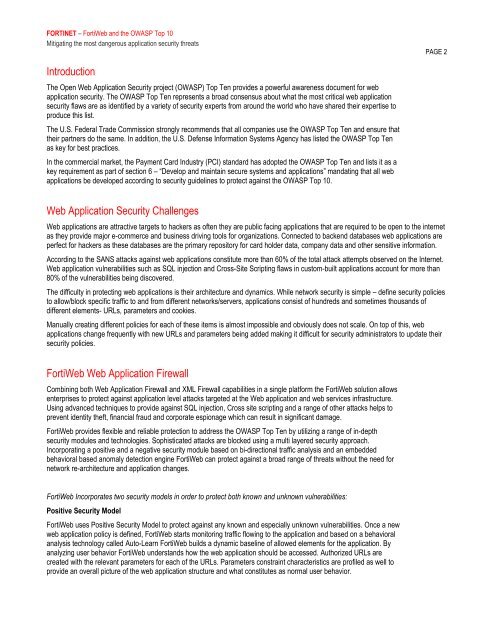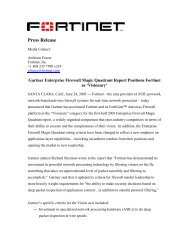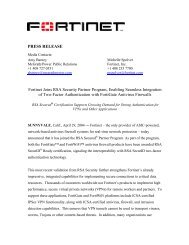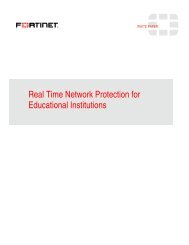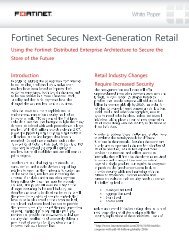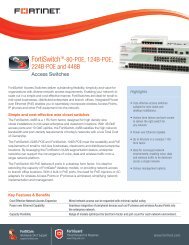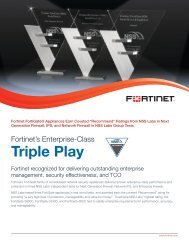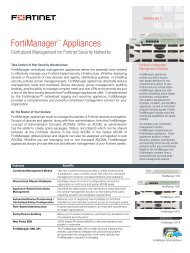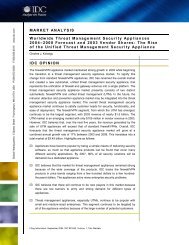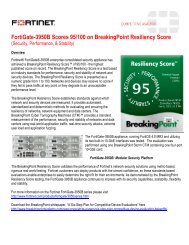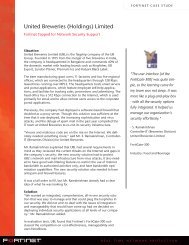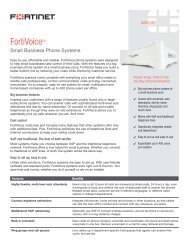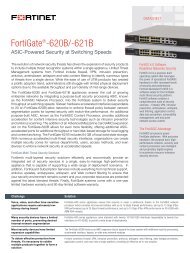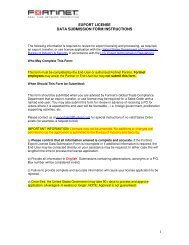FortiWeb and the OWASP Top 10 - Fortinet
FortiWeb and the OWASP Top 10 - Fortinet
FortiWeb and the OWASP Top 10 - Fortinet
Create successful ePaper yourself
Turn your PDF publications into a flip-book with our unique Google optimized e-Paper software.
FORTINET – <strong>FortiWeb</strong> <strong>and</strong> <strong>the</strong> <strong>OWASP</strong> <strong>Top</strong> <strong>10</strong><br />
Mitigating <strong>the</strong> most dangerous application security threats<br />
Introduction<br />
The Open Web Application Security project (<strong>OWASP</strong>) <strong>Top</strong> Ten provides a powerful awareness document for web<br />
application security. The <strong>OWASP</strong> <strong>Top</strong> Ten represents a broad consensus about what <strong>the</strong> most critical web application<br />
security flaws are as identified by a variety of security experts from around <strong>the</strong> world who have shared <strong>the</strong>ir expertise to<br />
produce this list.<br />
The U.S. Federal Trade Commission strongly recommends that all companies use <strong>the</strong> <strong>OWASP</strong> <strong>Top</strong> Ten <strong>and</strong> ensure that<br />
<strong>the</strong>ir partners do <strong>the</strong> same. In addition, <strong>the</strong> U.S. Defense Information Systems Agency has listed <strong>the</strong> <strong>OWASP</strong> <strong>Top</strong> Ten<br />
as key for best practices.<br />
In <strong>the</strong> commercial market, <strong>the</strong> Payment Card Industry (PCI) st<strong>and</strong>ard has adopted <strong>the</strong> <strong>OWASP</strong> <strong>Top</strong> Ten <strong>and</strong> lists it as a<br />
key requirement as part of section 6 – “Develop <strong>and</strong> maintain secure systems <strong>and</strong> applications” m<strong>and</strong>ating that all web<br />
applications be developed according to security guidelines to protect against <strong>the</strong> <strong>OWASP</strong> <strong>Top</strong> <strong>10</strong>.<br />
Web Application Security Challenges<br />
Web applications are attractive targets to hackers as often <strong>the</strong>y are public facing applications that are required to be open to <strong>the</strong> internet<br />
as <strong>the</strong>y provide major e-commerce <strong>and</strong> business driving tools for organizations. Connected to backend databases web applications are<br />
perfect for hackers as <strong>the</strong>se databases are <strong>the</strong> primary repository for card holder data, company data <strong>and</strong> o<strong>the</strong>r sensitive information.<br />
According to <strong>the</strong> SANS attacks against web applications constitute more than 60% of <strong>the</strong> total attack attempts observed on <strong>the</strong> Internet.<br />
Web application vulnerabilities such as SQL injection <strong>and</strong> Cross-Site Scripting flaws in custom-built applications account for more than<br />
80% of <strong>the</strong> vulnerabilities being discovered.<br />
The difficulty in protecting web applications is <strong>the</strong>ir architecture <strong>and</strong> dynamics. While network security is simple – define security policies<br />
to allow/block specific traffic to <strong>and</strong> from different networks/servers, applications consist of hundreds <strong>and</strong> sometimes thous<strong>and</strong>s of<br />
different elements- URLs, parameters <strong>and</strong> cookies.<br />
Manually creating different policies for each of <strong>the</strong>se items is almost impossible <strong>and</strong> obviously does not scale. On top of this, web<br />
applications change frequently with new URLs <strong>and</strong> parameters being added making it difficult for security administrators to update <strong>the</strong>ir<br />
security policies.<br />
<strong>FortiWeb</strong> Web Application Firewall<br />
Combining both Web Application Firewall <strong>and</strong> XML Firewall capabilities in a single platform <strong>the</strong> <strong>FortiWeb</strong> solution allows<br />
enterprises to protect against application level attacks targeted at <strong>the</strong> Web application <strong>and</strong> web services infrastructure.<br />
Using advanced techniques to provide against SQL injection, Cross site scripting <strong>and</strong> a range of o<strong>the</strong>r attacks helps to<br />
prevent identity <strong>the</strong>ft, financial fraud <strong>and</strong> corporate espionage which can result in significant damage.<br />
<strong>FortiWeb</strong> provides flexible <strong>and</strong> reliable protection to address <strong>the</strong> <strong>OWASP</strong> <strong>Top</strong> Ten by utilizing a range of in-depth<br />
security modules <strong>and</strong> technologies. Sophisticated attacks are blocked using a multi layered security approach.<br />
Incorporating a positive <strong>and</strong> a negative security module based on bi-directional traffic analysis <strong>and</strong> an embedded<br />
behavioral based anomaly detection engine <strong>FortiWeb</strong> can protect against a broad range of threats without <strong>the</strong> need for<br />
network re-architecture <strong>and</strong> application changes.<br />
<strong>FortiWeb</strong> Incorporates two security models in order to protect both known <strong>and</strong> unknown vulnerabilities:<br />
Positive Security Model<br />
<strong>FortiWeb</strong> uses Positive Security Model to protect against any known <strong>and</strong> especially unknown vulnerabilities. Once a new<br />
web application policy is defined, <strong>FortiWeb</strong> starts monitoring traffic flowing to <strong>the</strong> application <strong>and</strong> based on a behavioral<br />
analysis technology called Auto-Learn <strong>FortiWeb</strong> builds a dynamic baseline of allowed elements for <strong>the</strong> application. By<br />
analyzing user behavior <strong>FortiWeb</strong> underst<strong>and</strong>s how <strong>the</strong> web application should be accessed. Authorized URLs are<br />
created with <strong>the</strong> relevant parameters for each of <strong>the</strong> URLs. Parameters constraint characteristics are profiled as well to<br />
provide an overall picture of <strong>the</strong> web application structure <strong>and</strong> what constitutes as normal user behavior.<br />
PAGE 2


